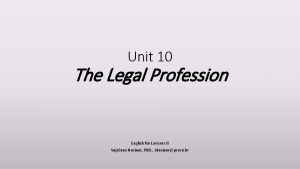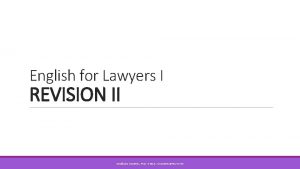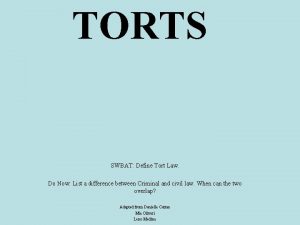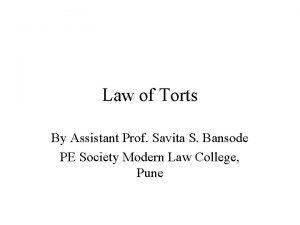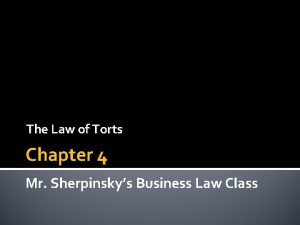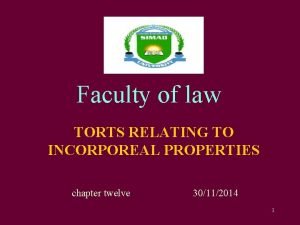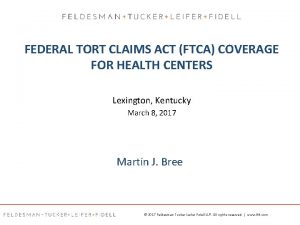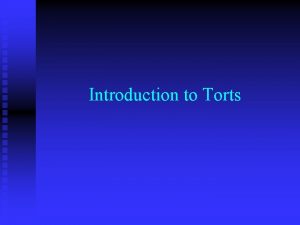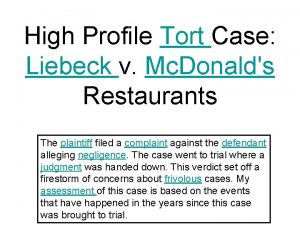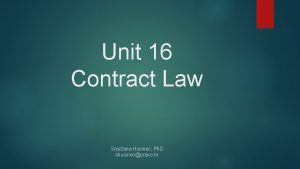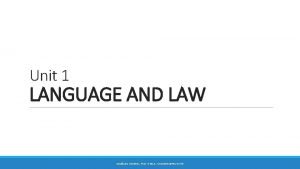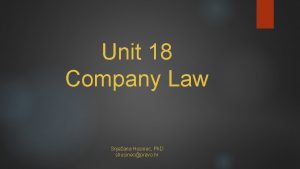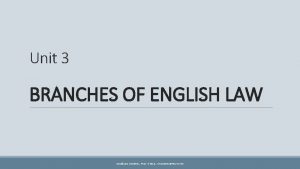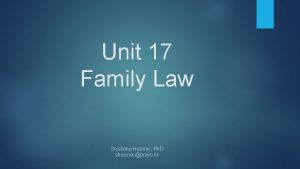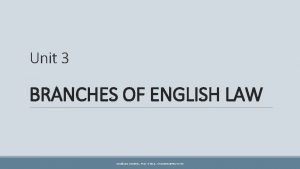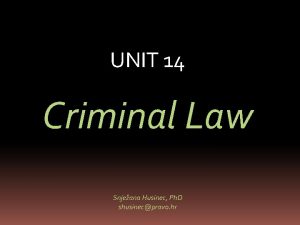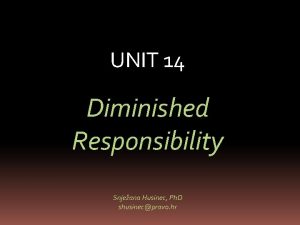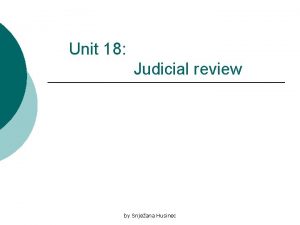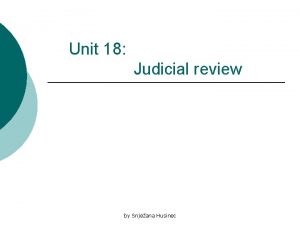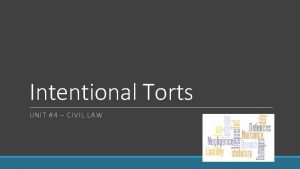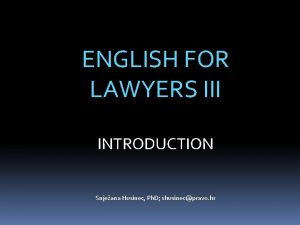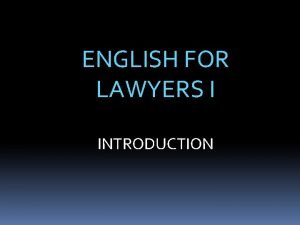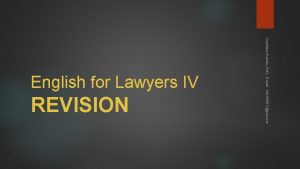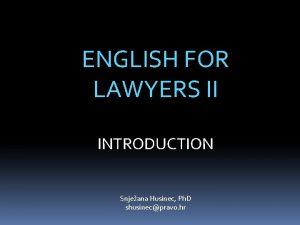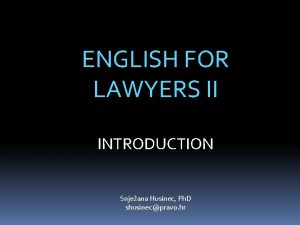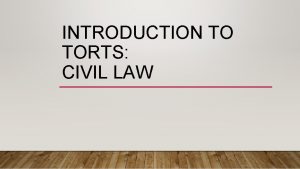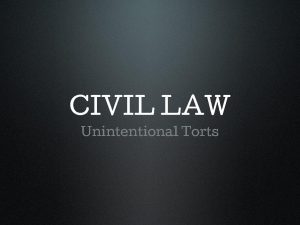Unit 15 The Law of Torts Snjeana Husinec






















- Slides: 22

Unit 15 The Law of Torts Snježana Husinec, Ph. D shusinec@pravo. hr

CRIMINAL LAW vs. CIVIL LAW Remember the differences between criminal and civil law. Which main areas/branches of civil law do you know of? Remember situations where obligations exist between parties to a contract. Can you think of a situation where there is an obligation, but no contract involved?

CRIME vs. TORT 1. Fill in the first column of the table based on what you have learned about criminal law. 2. Read the introductory text on torts and complete column 2. 3. Find similarities and differences between torts and crimes. CRIMES TORTS Area of law. - … Act and result. - Crimes involve situations where … Act and result. - Torts involve situations where … Object. - of criminal law is to … Object. - Of the law of torts is to … Parties. - A criminal is prosecuted by … Parties. - Action is taken by … Categories of crimes. - … Main groups of torts. - …

Torts against Land the Person a) Do ex. III on p. 140 c) Read the text on p. 140 a second time and take out the characteristics of each of the 6 torts. Tort TRESPASS TO LAND NUISANCE ASSAULT BATTERY FALSE IMPRISONMENT DEFAMATION Characteristics

Torts against the land the person Do ex. IV. When is a tort ¨actionable per se¨? Which torts are ¨actionable per se¨? Do ex. VI and VII.

DAMAGE v. DAMAGES DAMAGE – injury or loss sustained by the claimant DAMAGES – compensation (financial) sought by the claimant, and awarded by the court for the harm suffered by the claimant

Case studies Analyze the case summaries in ex. VIII and decide whether they constitute 1. Trespass 2. Nuisance 3. False imprisonment 4. Assault Are the legal requirements met. Give arguments for your answers.

A „TORT” STORY Think about a situation in your life where a tort has been committed or may be committed. Make up a „tort story” in which you, your family, friends or neighbours are involved. Describe the event precisely to show the details of the tort committed, but do not mention the name of the tort. Join in groups of 4, read your stories to each other and let the group guess which tort has been committed. HA. Find a newspaper clip or a piece of web news about a certain tort which has recently been committed in Croatia or in an English speaking country.

Consider the following case. Was a tort committed? What type of tort? Mrs Walker was in the supermarket picking up one or two things for dinner. She walked around the corner from the cheese display into the bakery aisle and slipped on something on the floor. This later turned out to be yoghurt. She fell and her right arm got painfully caught in the basket she was carrying. The basket wrapped itself around her arm as she fell. She experienced significant pain in her right arm and shoulder, and this did not improve overnight. Therefore, she went to see her doctor, who referred her to the hospital for physiotherapy and put her on a course of painkillers. Xrays taken at the hospital showed that she had sustained damage to her arm and shoulder muscles. 1. Could the supermarket have foreseen and prevented the accident? Did they owe any kind of duty to Mrs Walker? 3. How was this duty breached? 4. Would she have fallen, if the floor had been cleaned regularly? Is there cause and effect connection between the spilt yoghurt and her fall? 5. Has she suffered any damage? Is it provable? = Think of other situations in which one person should act wih care towards another and fails to provide it?

Negligence § failure to exercise the care toward others which a reasonable or prudent person would do in the circumstances, or taking action which such a reasonable person would not Donoghue vs. Stevenson (1932)

Elements of a negligence claim Liability for negligence can be proved only if the following elements are identified: Duty of care (towards a plaintiff/claimant) B) Breach of duty (on the part of the defendant) C) Causation (cause and effect connection between the breach and the harm) D) Damage (injury or harm as a consequence of the breach) A)

The ‘neighbour principle’ Lord Atkin in Donoghue v. Stevenson (1932) said: ``You must take reasonable care to avoid acts or omissions which you can reasonably foresee would be likely to injure your neighbour. Who, then, in law is my neighbour? The answer seems to be - persons who are so closely and directly affected by my act that I ought reasonably to have them in contemplation as being so affected when I am directing my mind to the acts or omissions which are called in question. '‘

Breach of duty of care Read the text and: A) do ex. III on p. 149 -150. B) Explain the following terms: 1. Duty of care 2. Breach of duty of care 3. Standard of care 4. Reasonable forseeability of harm

Standard of care What provides a standard of care by which a person’s conduct is judged? = the standard of care that must be exercised is that which a reasonable person would use under similar circumstances (being a fool is not an excuse from that standard of care) Consequences that should be prevented must be reasonalby forseeable

The floodgates argument a type of argument based on policy considerations or "the bigger picture" rather than the just result in an individual case - a judge decides not to act in a particular case regardless of how good the plaintiff's case is to avoid numerous frivoulous lawsuits that might follow if a precedent is established Example: If one were to be successful in a claim against an employer in fear of contracting a disease or illness due to the exposure of chemical agents, then, of course, this would lead to hundreds of thousands of other employees bringing similar claims. Fletcher v. The Commissioners of Public Works in Ireland (2003) Keane C. J. : “the ground for not extending liability to all forms of economic loss. . . is the undesirability of courts extending the range of possible liability in so uncontrolled and indeterminate a manner without any legislative intervention”

Causation Was it the breach that caused the damage? ‘but for’ test: Would the claimant have been injured / suffered the damage but for the negligent act of the defendant? If NO – breach of duty of care = there is causation = defendant is liable If YES – no breach of duty of care = there is no causation = defendant not liable = Not always easy to prove = DAMAGE must be proved on a BALANCE OF PROBABILITIES BREAKING THE CHAIN OF CAUSATION If broken – causation cannot be established - A natural event - An action by a third party - An action by the claimant

Causation Palsgraf v. Long Island R. R. Co. (N. Y. 1928) Discuss the case. Is negligence involved? Facts Mrs. Palsgraf (P) was standing on a Long Island Railroad (D) train platform when two men ran to catch a train. The second man was carrying a small package containing fireworks. He was helped aboard the train by one guard on the platform and another on the train. The man dropped the package which exploded when it hit the tracks. The shock of the explosion caused scales at the other end of the platform many feet away to fall, striking and injuring Palsgraf brought a personal injury lawsuit against Long Island Railroad and the railroad appealed the court’s judgment in favor of Palsgraf. The judgment was affirmed on appeal and Long Island Railroad appealed. Issues How is the duty of due care that is owed determined? To whom does a party owe the duty of due care?

Holding and Rule (Cardozo – “Zone of Danger” rule) = A duty that is owed must be determined from the risk that can reasonably be foreseen under the circumstances. = A defendant owes a duty of care only to those who are in the reasonably foreseeable zone of danger. = The court held that the conduct of Long Island Railroad’s guard was wrongful in relation to the man carrying the parcel, but not in relation to Palsgraf standing far away. No one was on notice that the package contained fireworks which when dropped could harm a person as far from the zone of danger as Palsgraf. = To find negligence there must first be a finding that a duty was owed and breached, and that the injury could have been avoided if the defendant had been following that duty. The orbit of the danger or risk associated with a danger or risk is that which a reasonable person would foresee. Even if the guard had intentionally taken the package and thrown it he would not have threatened Palsgraf’s safety from the appearances of the circumstances to a reasonable person. Long Island Railroad’s liability for an inadvertent or unintentional act cannot be greater than it would be if the act had been intentional.

Disposition Reversed – judgment for Long Island Railroad. Dissent (Andrews) Everyone owes the world at large the duty of refraining from acts that may unreasonably threaten the safety of others. In determining proximate cause the court must ask whethere was a natural and continuous sequence between the cause and effect and not whether the act would reasonably be expected to injure another. The court must consider that the greater the distance between the cause and the effect in time and space, the greater the likelihood that other causes intervene to affect the result. In this case there was no remoteness in time and little in space. Injury in some form was probable. Notes The majority adopted the principle that negligent conduct resulting in injury will lead to liability only if the actor could have reasonably foreseen that the conduct would cause the injury. In a 4 -3 opinion by Cardozo, the court held that the Long Island Railroad attendants could not have foreseen the possibility of injury to Palsgraf and therefore did not breach any duty to her. Andrews asserted that the duty to exercise care is owed to all, and thus a negligent act will subject the actor to liability to all persons proximately harmed by it, whether or not the harm is foreseeable. Both opinions have been widely cited to support the two views expressed in them. The reasoning in this case was that Long Island Railroad did not owe a duty of care to Palsgraf insofar as the package was concerned. Cardozo did not reach the issue of “proximate cause” for which the case is often cited. There is no general principle that a railroad owes no duty to persons on station platforms not in immediate proximity to the tracks, as would have been the case if Palsgraf had been injured by objects falling from a passing train. (source: http: //www. lawnix. com/cases/palsgraf-long-island-railroad. html)

Strict liability Absolute legal responsibility for an injury that can be imposed on th e wrongdoer without proof of carelessness or fault. Strict liability (also absolute liability) = the legal responsibility for damages, or injury, even if the person foun d strictly liable was not at fault or negligent. Strict liability has been applied to certain activities in TORT, such as ho lding anemployer absolutely liable for the torts of her employees (today it is most commonly associated with defectively manufactured products).

Vocabulary practice I Translate into Croatian. 1. unreasonable conduct 8. to lawfully remove a trespasser 2. to be sufficiently serious to constitute a crime 9. to claim false imprisonment 3. dispute as to title 4. to evict a tenant in breach of the rental agreement 10. a lawsuit in trespass 11. to file a trespass lawsuit 12. to sustain / suffer damage 5. an action in tort 13. reasonable forseeability of harm 6. to have no legal claim on the property 14. non-tortious risk 7. to refrain from the nuisance

Vocabulary practice II Paraphrase in English. 1. to be actionable per se 2. defamatory statements in permanent form 3. to award nominal / exemplary damages 4. to constitute grounds for a nuisance lawsuit 5. unlawful interference with another’s land 6. deprivation of freedom of movement 7. to warrant a court order of damages 8. to establish reasonable forsight 9. breach of duty of care 10. contributory negligence 11. reasonable foreseeability of harm
 Snježana husinec
Snježana husinec Snježana husinec
Snježana husinec Definition of law of torts
Definition of law of torts Injuria sine damno and damnum sine injuria difference
Injuria sine damno and damnum sine injuria difference Types of torts in healthcare
Types of torts in healthcare Unintentional tort examples
Unintentional tort examples Incorporeal examples
Incorporeal examples Federal tort claim act coverage
Federal tort claim act coverage Torts class
Torts class Torts case
Torts case Newton's first law and second law and third law
Newton's first law and second law and third law Si unit of newton's first law
Si unit of newton's first law V=k/p
V=k/p How to calculate boyle's law
How to calculate boyle's law Unit 6 review questions
Unit 6 review questions Hình ảnh bộ gõ cơ thể búng tay
Hình ảnh bộ gõ cơ thể búng tay Frameset trong html5
Frameset trong html5 Bổ thể
Bổ thể Tỉ lệ cơ thể trẻ em
Tỉ lệ cơ thể trẻ em Voi kéo gỗ như thế nào
Voi kéo gỗ như thế nào Glasgow thang điểm
Glasgow thang điểm Chúa sống lại
Chúa sống lại Môn thể thao bắt đầu bằng chữ f
Môn thể thao bắt đầu bằng chữ f
